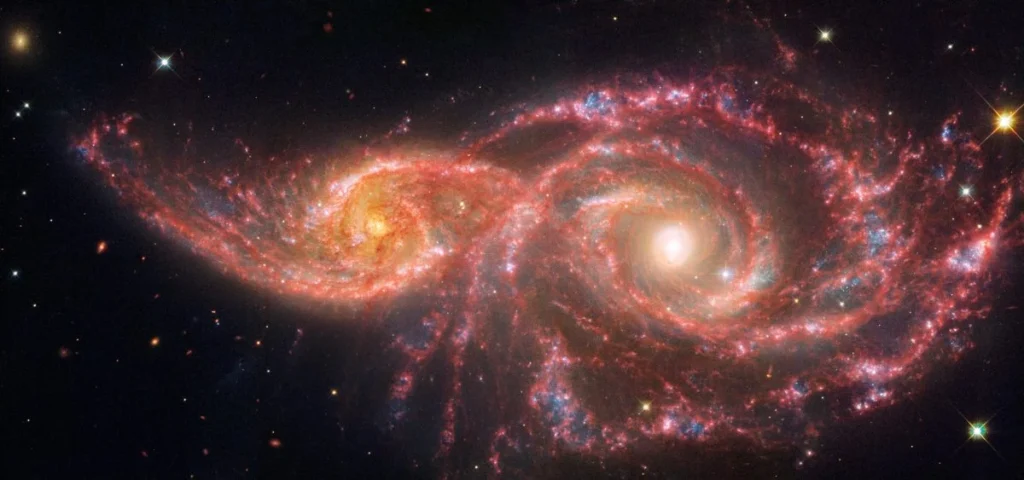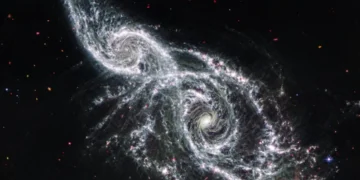In the latest jaw-dropping images from NASA, two neighboring galaxies appear almost otherworldly—like a pair of haunting, “blood-soaked eyes” peering out of the cosmos. These images, captured by NASA’s James Webb and Hubble Space Telescopes, depict galaxies IC 2163 and NGC 2207 in a stunningly surreal form. For the first time, scientists have seen this pair with unprecedented clarity, using a blend of mid-infrared, visible, and ultraviolet light. The result? A chilling and mesmerizing vision of our universe’s strange beauty and violence.
The Collaborative Power of Webb and Hubble: High-Resolution Meets Multispectral Depth
Combining the capabilities of two of the world’s most powerful telescopes—Webb and Hubble—produces images unlike any we’ve seen before. The Webb telescope’s mid-infrared imaging peels back layers of interstellar dust, while Hubble’s visible and ultraviolet light captures intricate details in unprecedented resolution. This collaboration between NASA’s two powerhouse telescopes has given us a look at IC 2163 and NGC 2207 with unparalleled clarity, allowing astronomers to see beyond the limits of what each telescope could achieve alone.

The result is a remarkably detailed image that reveals every nuance of this galactic interaction. From shock fronts where galaxies collided to red-tinted “eyelids” shaped by gravitational forces, each element of the image tells a story. Through this unique view, astronomers gain insights into how galaxies evolve and the physical processes at play when two galactic bodies come close enough to tug at each other’s stars, gas, and dust.
An Ancient Dance: How Galactic Encounters Shape Cosmic Structure
This close encounter between IC 2163 and NGC 2207 isn’t a chance event—it’s part of a gravitational dance that began millions of years ago. When galaxies move close enough to one another, their gravitational pulls can distort their shapes, as each galaxy tugs on the stars, dust, and gas in the other. Over time, these encounters can reshape spiral arms, ignite star formation, and even merge two galaxies into one larger structure.

For IC 2163 and NGC 2207, this encounter appears to have begun with IC 2163 “slithering” behind the larger NGC 2207. As it passed by, the smaller galaxy’s spiral arms stretched and distorted, forming a pattern of bright red-tinted features that look like eyelids around an eye. These shock fronts are a testament to the gravitational push and pull at play, as each galaxy leaves its mark on the other.
The distortions caused by these interactions are more than just eye-catching; they’re a way for astronomers to study the fundamental forces shaping galaxies. Each ripple, twist, and bulge in the galaxies’ structures provides clues to the mass, density, and speed of the matter within.
The Stellar Nurseries: Star Formation on Overdrive
One of the most fascinating aspects of this observation is the high rate of star formation occurring in both galaxies. While the Milky Way produces only two or three Sun-sized stars annually, these two galaxies are generating nearly two dozen new stars each year. This rapid star formation rate is visible as glowing, bright blue patches in the images captured by Hubble and Webb.
These areas, known as stellar nurseries, are where new stars are born. The gas and dust in these regions collapse under gravity, heating up until nuclear fusion ignites, giving birth to a star. The high level of star formation in IC 2163 and NGC 2207 suggests that their encounter may be fueling these stellar nurseries by compressing clouds of gas and dust within each galaxy.
Some regions even appear to be “mini starbursts”—areas where stars form rapidly and in quick succession, resulting in clusters of bright, young stars.
Echoes of Ancient Supernovae: Clues in the Cosmic Debris
The new image also captures remnants of ancient supernovae that exploded long ago within the galaxies. Supernovae play a pivotal role in galactic evolution: they disperse heavy elements throughout the galaxy, enriching future generations of stars and planets.
When stars go supernova, they scatter materials like carbon, oxygen, and iron—elements crucial for the formation of planets and, ultimately, life. Each supernova remnant in IC 2163 and NGC 2207 is not just a reminder of past stellar explosions but also a symbol of the ongoing cosmic cycle of birth, death, and rebirth that fuels the universe’s evolution.
In the Webb and Hubble images, these remnants are highlighted by Webb’s infrared capabilities, which penetrate the dust and gas surrounding the remnants. This lets astronomers study them in detail, piecing together the conditions that led to their formation and the role they play in the galaxies’ current state.
Looking to the Future: Galactic Evolution on a Cosmic Scale
The images of IC 2163 and NGC 2207 are more than just a snapshot—they’re a time capsule. Over millions of years, these galaxies may continue their gravitational dance, passing close to one another multiple times until they eventually merge. Each pass brings them closer to blending into a single, massive galaxy, complete with entirely reshaped arms and a core that might appear as a cyclopean “eye” at the center.
This process, while incredibly slow on human timescales, is a common fate for galaxies. In fact, our Milky Way is on a collision course with the Andromeda galaxy, with an anticipated collision expected in about 4.5 billion years. By studying IC 2163 and NGC 2207, astronomers gain insights that could help predict the future of our galaxy and understand the broader patterns of galactic evolution across the cosmos.
Why This Discovery Matters: Illuminating the Universe’s Secrets
The eerie beauty of the “blood-soaked eyes” image isn’t just about aesthetics. This discovery is a reminder of the universe’s scale, power, and complexity. Every galaxy, star, and planet exists as part of a grand cosmic tapestry where gravity, time, and space interact in ways we are only beginning to understand. The observations from Webb and Hubble add another piece to this puzzle, helping scientists develop more accurate models of galactic formation and evolution.
Galaxies like IC 2163 and NGC 2207 are invaluable laboratories for studying fundamental cosmic processes. From star formation and supernovae to the physics of galactic collisions, every detail of this galactic pair holds secrets that can reveal how the universe has evolved from the Big Bang to today.
Conclusion: A Cosmic Dance Under Blood-Red Light
The haunting image of IC 2163 and NGC 2207 serves as a powerful reminder of the mysteries and wonders that lie beyond our solar system. Through the combined efforts of Webb and Hubble, astronomers have painted a vivid picture of galactic interaction, star formation, and cosmic evolution. And while we can only witness a brief moment in these galaxies’ long lives, each discovery brings us closer to understanding the universe’s ever-unfolding story. So next time you gaze at the night sky, remember that beyond those distant stars lies a dance of cosmic forces, painting scenes that are stranger—and more beautiful—than anything we can imagine.



















